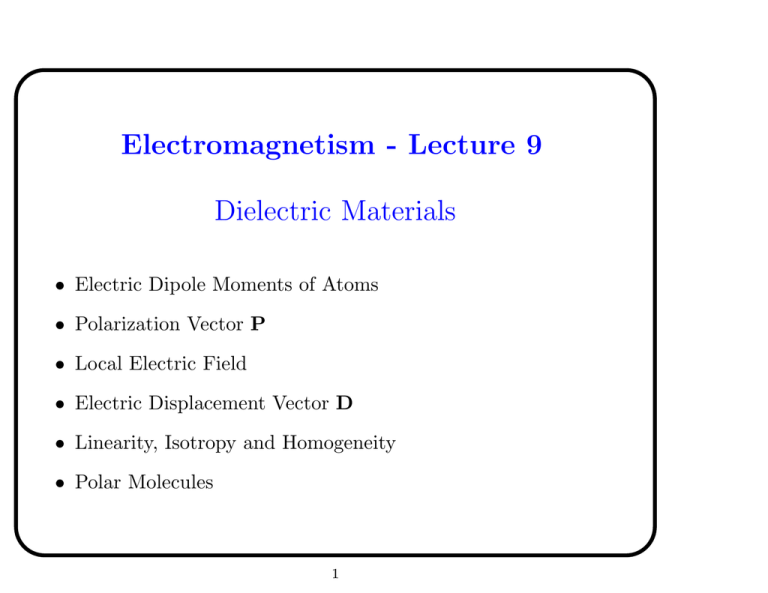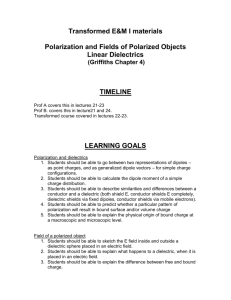Electromagnetism - Lecture 9 Dielectric Materials
advertisement

Electromagnetism - Lecture 9 Dielectric Materials • Electric Dipole Moments of Atoms • Polarization Vector P • Local Electric Field • Electric Displacement Vector D • Linearity, Isotropy and Homogeneity • Polar Molecules 1 Polarizability of Atoms In an insulator the electrons are bound to the atomic lattice and cannot move freely ... but in the presence of an external electric field E each atom becomes slightly polarized The atomic dipole moment is: p = Zea = α0 EL where the separation between the centroid of the electron cloud and the atomic nucleus is small compared to the Bohr radius: |a| ≈ 10−15 m = 10−5 a0 α is known as the atomic or molecular polarizability EL is the local electric field inside the material which is not identical to the external field E 2 Polarization Vector & Susceptibility The atomic dipole moment can be expressed as in integral over the atomic charge density: Z rρdτ p= atom The dipole moment density is the polarization vector P: P= dp =< rρ >atom dτ The polarization vector is proportional to the external field E: P = χE 0 E where χE is the electric susceptibility of the material 3 Notes: Diagrams: 4 Polarization Flux The polarization flux through a surface has units of charge: d(p.n̂) = −QP dl The polarization charge QP is equivalent to induced surface charges σP = ∓|P| on the surfaces perpendicular to the external field P.dS = Integrating the polarization flux over a closed surface Z I I d(p.n̂) =− P.dS = ρP dτ dl A A V where ρP is the polarization charge density Using the divergence theorem: ∇.P = −ρP The distributions σP and ρP represent the effect of the atomic polarization with equivalent macroscopic charge distributions 5 Local Electric Field Inside the material the polarization vector P modifies the local electric field EL compared to the external electric field E P χE E = 1+ EL = E + 30 3 The factor 1/3 will be derived in a later lecture The polarization vector can be expressed microscopically in terms of EL and macroscopically in terms of E: P = NA α0 EL P = χE 0 E where NA is Avogadro’s number and α is the atomic polarizability χE χE = N A α 1 + 3 χE = For small polarizability NA α 1: 6 NA α (1 − NA α/3) χE ≈ NA α and EL ≈ E Notes: Diagrams: 7 Notes: Diagrams: 8 Electric Displacement Vector Gauss’s Law is modified to include polarization effects: I Z 1 (ρC + ρP ) E.dS = (ρC + ρP )dτ ∇.E = 0 V 0 A where ρC are free charges (if any). Using ∇.P = −ρP this can be rewritten as: ∇.P ρC − ∇.E = 0 0 ∇.(0 E + P) = ρC The electric displacement vector D is: D = 0 E + P ∇.D = ρC Note that D and P have units Cm−2 , whereas E is in V m−1 9 Dielectric Constant The linear relationships between D, E and P: D = 0 E + P P = χ E 0 E can be expressed in terms of a dielectric constant r D = r 0 E r = 1 + χE For most dielectrics χE 1 and r is slightly above 1 This reflects the small atomic polarizability α of most materials General advice - wherever 0 appears in electromagnetism, it should be replaced by r 0 for insulators 10 LIH Dielectrics Implicit in the idea of a dielectric constant for a material are certain assumptions: • Linearity - the polarization is proportional to the magnitude of E. This breaks down at high electric fields. • Isotropy - the polarization is independent of the direction of E. Some crystals are anisotropic, particularily under mechanical stress. Known as the piezoelectric effect. • Homogeneity - the polarization is the same everywhere in the material. Materials satisfying these conditions are known as LIH dielectrics Most insulators are LIH dielectrics 11 Notes: Diagrams: 12 Polar Dielectrics Some molecules have an intrinsic dipole moment p =ea, where |a| ≈ 10−10 is the molecular size. These polar dielectrics have large dielectric constants. An example is water with r = 81 at room temperature In the absence of an external field E the molecular dipoles are randomly oriented and P = 0 In the presence of an external E the molecular dipoles align with the field to generate a large P 13 Susceptibility of Polar Dielectrics The alignment of the dipoles with the external field is disrupted by thermal motion: N (θ)dθ ∝ e−U/kT sin θdθ U = −p.E = −pE cos θ Expanding the exponent under the assumption that U kT and integrating over the orientation angle θ: NA |p|2 E P= 3kT The susceptibility χE decreases with increasing temperature 2 |p| χE = N A α + 30 kT where the first term is the usual LIH dielectric result, and the second term applies to polar dielectrics. 14 Energy Storage in Dielectrics The capacitance of a capacitor increases if the gap is filled with a dielectric material: C = r C0 Hence the energy stored in a capacitor increases: 1 U = CV 2 = r U0 2 The energy density of the electric field also increases: 1 1 dUE 2 = r 0 E = D.E dτ 2 2 These are very large effects for polar dielectrics... a lot of electric energy can be stored in a water bath! 15 Notes: Diagrams: 16





